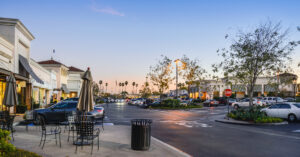Despite recent uncertainty in the capital markets, the Southeastern U.S. is booming. Lower costs of living, less traffic, better weather and a lighter regulatory structure have driven population growth across the region, which was growing at about twice the national average before the COVID-19 pandemic. The health crisis seemingly accelerated this trend, with an enormous number of people and capital flooding into Southeastern markets.
But even in the Southeast, growth is uneven across property types, and the dynamics are similar to those in the rest of the country. In fact, this region may be an example of how the rest of the nation’s commercial real estate markets will evolve going forward.
Activity in the multifamily sector has been, if anything, even more frenzied than that of the industrial sector.
Like much of the country, the industrial and multifamily housing sectors in the Southeast have been on fire, with record prices across the region. Hotels are generally performing well, with a few exceptions. The office sector has performed less well but also has exceptions. And while the retail sector continues to struggle everywhere, rents have been increasing in many Southeastern markets, especially for grocery store-anchored strip retail properties.
Industrial surge
Demand for industrial assets have been seemingly insatiable. In established corridors —
such as Interstate 75 in central Florida, and the confluence of Interstates 85 and 26 near Spartanburg, South Carolina — assets are trading at record prices. This past March, for instance, an industrial property near Tampa sold for a whopping $497 per square foot.
What is most remarkable, however, is the degree to which less established industrial markets are seeing a surge in activity. The Raleigh area, for example, has not historically been an important industrial market, yet it is seeing massive new construction such as Amazon’s 620,000-square-foot distribution center in Smithfield, North Carolina (about 35 miles from downtown Raleigh, near Interstate 95).
In other markets outside the Southeast, it seems prudent to expect more fragmentation. A traditional industrial corridor such as Southern California’s Inland Empire will continue to boom. Less established markets will likely depend on relative population growth.
Multifamily frenzy
Activity in the multifamily sector has been, if anything, even more frenzied than that of the industrial sector. As an example, Greenville, South Carolina (which had very few multi-family developments 10 years ago) delivered more than 500 apartment units in the first quarter of this year alone. Between 2010 and 2020,
Charlotte had the fastest-growing supply of apartments in the country, according to RealPage Inc., a Texas-based real estate analytics firm. Since 2010, the city has had more than 55,000 apartment units completed, and more are on the way. RealPage also listed Austin, Nashville and Raleigh-Durham among the top five U.S. metro areas for apartment-inventory increases during the period.
Some Southeastern markets, such as Miami and Atlanta, have long-established multifamily sectors. In markets such as Greenville or Charlotte, however, it is still a relatively new property type without decades of absorption data. This has led to significant uncertainty about how the multifamily market will behave in a downturn. These doubts, however, are not reflected in unit pricing. In Charlotte, for instance, this year’s average rents are up 10% to 14% from 2021.
In the rest of the country, multifamily demand likely is supported by higher mortgage rates, as the marginal homebuyer is less likely to be able to afford to purchase. But the degree of pricing power for landlords is unclear with so much new supply coming to market, and there are questions whether long-term owners will be able to drive rents higher, as they are assuming. Lenders and their advisors should think carefully about rent-growth assumptions under such conditions.
The hospitality sector has generally been booming across the Southeast, with a particular focus on leisure travel. Business travel also is recovering but is expected to remain below pre-pandemic levels. Miami, Orlando and Tampa are home to some of the strongest hotel markets in the country.
Areas of concern include a labor shortage and submarkets that are oversupplied, where too many rooms were added prior to the pandemic. Nevertheless, unlike many U.S. markets that were overbuilt (New York is a good example), Southeastern hotel markets are generally performing well.
The office puzzle
The office sector is maybe the most puzzling. Aggregate demand is clearly declining as tenants reevaluate their space needs. Even within the booming markets of the Southeast, office tenants can afford to be choosy. The best buildings in the best locations are able to stay full and generally maintain their rent prices, although landlords may not be driving rates the way they originally hoped.
New buildings with superior tenancy still command premium pricing, as shown by the
December 2021 sale of Honeywell’s 374,000-square-foot headquarters in Charlotte. The building sold for $275 million, or $735 per square foot, close to a record for a Charlotte office asset. While rents are generally rising, growing Southeastern markets have plenty of sublease space available, even in new buildings.
The same phenomenon is playing out across the country: There is a real flight to quality, meaning that older, less well-located buildings will struggle. Commercial mortgage lenders and brokers should note that rising construction costs and slower rent growth may make it more difficult to stay ahead of tenant improvement expenses, which can chew up an office building’s profitability.
Location is crucial
There also is a shift in thinking about what represents a strong location. Duke Energy’s decision to sign a long-term lease for office space in Charlotte’s Optimist Hall neighborhood is a good example. The project is a renovated textile mill in a trendy, emerging area adjacent to light rail and outside of the central business district, but it is not an obvious location for an $80 billion utility company.
The flight-to-quality trend is occurring in real estate centers around the country, including New York City, where HSBC is moving its U.S. headquarters to the Spiral, a new tower on the west side of Manhattan. HSBC is among a group of tenants moving out of the city’s Midtown office district. The bank reportedly was attracted to the green amenities at the Spiral, such as advanced air filtration. The lower carbon emissions of new buildings also help tenants comply with their own environmental aspirations, with HSBC noting that its new headquarters will enable a 60% drop-off in energy consumption.
Meanwhile, the building that HSBC is vacating is in what used to be considered a prestigious location of central Manhattan. But the building is a glass tower that is no longer in vogue. It was sold in December 2021 for a $45 million loss compared to the seller’s original purchase price of $855 million.
Struggling retail
The retail sector continues to struggle in the Southeast and across the country, despite increased consumer spending. But there is a clear split between the large destination malls and smaller-format strip retail with grocery-anchored stores.
Triangle Town Center, a 474,000-square-foot mall located amid the strongest demographic submarket in Raleigh (itself one of the fastest-growing metro areas in the country) is a good example. The 20-year-old mall sold in November 2021 for $33 million, or 81% below its previous sales price of $174 million in 2016.
On the other hand, many smaller retail strips appear to be attracting strong interest from both lenders and equity investors. In Cary, North Carolina, an 18,600-square-foot strip center adjacent to a Wegmans grocery store sold in March 2022 for $12.8 million, or about $688 per square foot. Somewhat more typical was the sale this past December of a Kroger-anchored, 201,000-square-foot retail center in Atlanta for $16.2 million, or about $80 per square foot.
● ● ●
Commercial mortgage brokers and lenders can’t ignore the Southeast and its extraordinary growth in population, new businesses and real estate developments. This region is leading the way on many fronts while also reflecting what is happening in real estate markets across the country. ●
-
Lee H. Roberts is managing partner of SharpVue Capital, a private investment management company based in Raleigh, North Carolina. He has spent more than 20 years in real estate finance and investments, including roles in private equity, investment banking and commercial banking. He previously served as budget director for the state of North Carolina, where he led an effort to rationalize the state’s real estate portfolio.
View all posts





